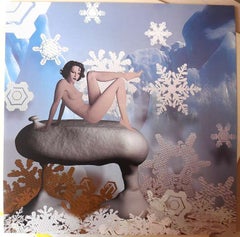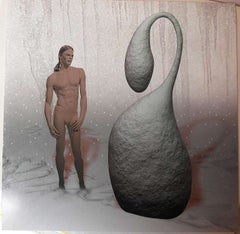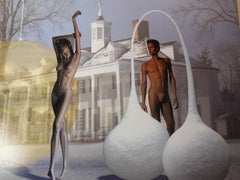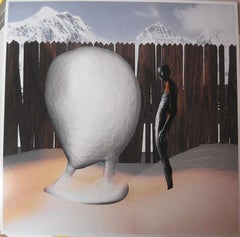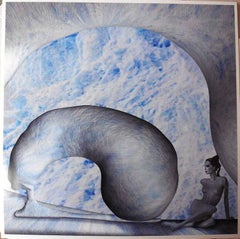Lions Gallery
to
3,403
1,312
915
463
393
370
324
307
170
89
79
59
52
25
16
16
10
2
2
24
20
17
14
11
Period: 1990s
Holiday Situations #1
By Charles Long
Located in Surfside, FL
HOLIDAY SITUATIONS,1999, color c-prints on Fuji crystal archive paper, each initialed on verso and inscribed "BAT" sheets 11 ¾ x 11 ¾", printed & published by Muse X, Los Angeles.
(...
Category
1990s Surrealist Nude Prints
Materials
C Print
Holiday Situations #9
By Charles Long
Located in Surfside, FL
HOLIDAY SITUATIONS,1999, color c-prints on Fuji crystal archive paper, each initialed on verso and inscribed "BAT" sheets 11 ¾ x 11 ¾", printed & published by Muse X, Los Angeles.
(male nude manikin with green sculpture), 1999
in the collection of Harvard University art museum where it is described as an Ink jet digital print
Born in 1958 in Long Branch, New Jersey, Long currently lives and
works in California.Education B.F.A., University of the Arts, Phila,
PA; Whitney Independent Study Program, New York, NY; M.F.A., Yale
University, New Haven, CT. Since then, the artist has received a
number of honors and awards, most recently the 2008 Award of Merit
Medal for Sculpture from the American Academy of Arts and Letters in
New York. He currently teaches as a professor in the Art Department at
the University of California, Riverside.
Long’s work has been the subject of major exhibitions worldwide. His
most important solo presentations include CATALIN at The Contemporary
Austin in Texas (2014), Fountainhead, a public commission in Dallas,
Texas organized by the Nasher Sculpture Center (2013), Pet Sounds at
Madison Square Park in New York City (2012), Seeing Green, a solo
project in conjunction with All of this and nothing: The 6th Hammer
Invitational at the UCLA Hammer Museum in Los Angeles (2011), 100
Pounds of Clay at Orange County Museum of Art in California (2010),
and More Like a Dream Than a Scheme at David Winton Bell Gallery at
Brown University in Rhode Island, which traveled to SITE Santa Fe in
New Mexico (2005). His work has been included in many significant
museum exhibitions such as the 1997 and 2008 Biennials, Whitney Museum
of American Art New York; Open Ends, The Museum of Modern Art; NYC.
Performance Anxiety, MCA, Chicago; Happiness, Mori Art Museum, Tokyo;
Arte Contemporáneo Internaciona, Museo de Arte Moderno, Mexico City;
ART/MUSIC: rock, pop, and techno Museum of Contemporary Art, Sydney;
Almost Warm and Fuzzy, Des Moines Art Center, The Shape of Color:
Excursions in Color Field Art, AGO/Art Gallery of Ontario, Canada;
Gone Formalism, The Institute of Contemporary Art, Philadelphia, PA;
The Uncertainty of Objects and Ideas, Hirshhorn Museum and Sculpture
Garden, Washington D.C. Sculpture Center in New York, Museum of
Contemporary Art Chicago, Magasin 3 Stockholm Konsthall, Hirshhorn
Museum and Sculpture Garden in Washington, D.C., Institute of
Contemporary Art, Philadelphia, Mori Art Museum in Tokyo, among other
museums.Long's sculptures have explored the abstract autonomous art
object as a psychological investigation into the nature self and
others and have been made from diverse media such as coffee grounds,
rubber and hair from Abraham Lincoln. He has collaborated with pop
musicians such as Stereolab, Mark Mothersbaugh...
Category
1990s Surrealist Nude Prints
Materials
C Print
Holiday Situations
By Charles Long
Located in Surfside, FL
HOLIDAY SITUATIONS,1999, color c-prints on Fuji crystal archive paper, each initialed on verso and inscribed "BAT" sheets 11 ¾ x 11 ¾", printed & published by Muse X, Los Angeles.
1...
Category
1990s Conceptual More Prints
Materials
C Print
Holiday Situations #2
By Charles Long
Located in Surfside, FL
HOLIDAY SITUATIONS,1999, color c-prints on Fuji crystal archive paper, each initialed on verso and inscribed "BAT" sheets 11 ¾ x 11 ¾", printed & published by Muse X, Los Angeles.
(female and male nude manikins in front of Mt Vernon), 1999
in the collection of Harvard University art museum where it is described as an Ink jet digital print
Born in 1958 in Long Branch, New Jersey, Long currently lives and
works in California.Education B.F.A., University of the Arts, Phila,
PA; Whitney Independent Study Program, New York, NY; M.F.A., Yale
University, New Haven, CT. Since then, the artist has received a
number of honors and awards, most recently the 2008 Award of Merit
Medal for Sculpture from the American Academy of Arts and Letters in
New York. He currently teaches as a professor in the Art Department at
the University of California, Riverside.
Long’s work has been the subject of major exhibitions worldwide. His
most important solo presentations include CATALIN at The Contemporary
Austin in Texas (2014), Fountainhead, a public commission in Dallas,
Texas organized by the Nasher Sculpture Center (2013), Pet Sounds at
Madison Square Park in New York City (2012), Seeing Green, a solo
project in conjunction with All of this and nothing: The 6th Hammer
Invitational at the UCLA Hammer Museum in Los Angeles (2011), 100
Pounds of Clay at Orange County Museum of Art in California (2010),
and More Like a Dream Than a Scheme at David Winton Bell Gallery at
Brown University in Rhode Island, which traveled to SITE Santa Fe in
New Mexico (2005). His work has been included in many significant
museum exhibitions such as the 1997 and 2008 Biennials, Whitney Museum
of American Art New York; Open Ends, The Museum of Modern Art; NYC.
Performance Anxiety, MCA, Chicago; Happiness, Mori Art Museum, Tokyo;
Arte Contemporáneo Internaciona, Museo de Arte Moderno, Mexico City;
ART/MUSIC: rock, pop, and techno Museum of Contemporary Art, Sydney;
Almost Warm and Fuzzy, Des Moines Art Center, The Shape of Color:
Excursions in Color Field Art, AGO/Art Gallery of Ontario, Canada;
Gone Formalism, The Institute of Contemporary Art, Philadelphia, PA;
The Uncertainty of Objects and Ideas, Hirshhorn Museum and Sculpture
Garden, Washington D.C. SculptureCenter in New York, Museum of
Contemporary Art Chicago, Magasin 3 Stockholm Konsthall, Hirshhorn
Museum and Sculpture Garden in Washington, D.C., Institute of
Contemporary Art, Philadelphia, Mori Art Museum in Tokyo, among other
museums.Long's sculptures have explored the abstract autonomous art
object as a psychological investigation into the nature self and
others and have been made from diverse media such as coffee grounds,
rubber and hair from Abraham Lincoln. He has collaborated with pop
musicians such as Stereolab, Mark Mothersbaugh...
Category
1990s Surrealist Nude Prints
Materials
C Print
Holiday Situations #10
By Charles Long
Located in Surfside, FL
HOLIDAY SITUATIONS,1999, color c-prints on Fuji crystal archive paper, each initialed on verso and inscribed "BAT" sheets 11 ¾ x 11 ¾", printed & published by Muse X, Los Angeles.
(black male nude manikin with white sculpture), 1999
in the collection of Harvard University art museum where it is described as an Ink jet digital print
Born in 1958 in Long Branch, New Jersey, Long currently lives and
works in California.Education B.F.A., University of the Arts, Phila,
PA; Whitney Independent Study Program, New York, NY; M.F.A., Yale
University, New Haven, CT. Since then, the artist has received a
number of honors and awards, most recently the 2008 Award of Merit
Medal for Sculpture from the American Academy of Arts and Letters in
New York. He currently teaches as a professor in the Art Department at
the University of California, Riverside.
Long’s work has been the subject of major exhibitions worldwide. His
most important solo presentations include CATALIN at The Contemporary
Austin in Texas (2014), Fountainhead, a public commission in Dallas,
Texas organized by the Nasher Sculpture Center (2013), Pet Sounds at
Madison Square Park in New York City (2012), Seeing Green, a solo
project in conjunction with All of this and nothing: The 6th Hammer
Invitational at the UCLA Hammer Museum in Los Angeles (2011), 100
Pounds of Clay at Orange County Museum of Art in California (2010),
and More Like a Dream Than a Scheme at David Winton Bell Gallery at
Brown University in Rhode Island, which traveled to SITE Santa Fe in
New Mexico (2005). His work has been included in many significant
museum exhibitions such as the 1997 and 2008 Biennials, Whitney Museum
of American Art New York; Open Ends, The Museum of Modern Art; NYC.
Performance Anxiety, MCA, Chicago; Happiness, Mori Art Museum, Tokyo;
Arte Contemporáneo Internaciona, Museo de Arte Moderno, Mexico City;
ART/MUSIC: rock, pop, and techno Museum of Contemporary Art, Sydney;
Almost Warm and Fuzzy, Des Moines Art Center, The Shape of Color:
Excursions in Color Field Art, AGO/Art Gallery of Ontario, Canada;
Gone Formalism, The Institute of Contemporary Art, Philadelphia, PA;
The Uncertainty of Objects and Ideas, Hirshhorn Museum and Sculpture
Garden, Washington D.C. SculptureCenter in New York, Museum of
Contemporary Art Chicago, Magasin 3 Stockholm Konsthall, Hirshhorn
Museum and Sculpture Garden in Washington, D.C., Institute of
Contemporary Art, Philadelphia, Mori Art Museum in Tokyo, among other
museums.Long's sculptures have explored the abstract autonomous art
object as a psychological investigation into the nature self and
others and have been made from diverse media such as coffee grounds,
rubber and hair from Abraham Lincoln. He has collaborated with pop
musicians such as Stereolab, Mark Mothersbaugh...
Category
1990s Surrealist Nude Prints
Materials
C Print
Holiday Situations #3
By Charles Long
Located in Surfside, FL
HOLIDAY SITUATIONS,1999, color c-prints on Fuji crystal archive paper, each initialed on verso and inscribed "BAT" sheets 11 ¾ x 11 ¾", printed & published by Muse X, Los Angeles.
(female nude manikin with blue sculpture and waves ), 1999
in the colection of Harvard University art museum where it is described as aInk jet digital print
Born in 1958 in Long Branch, New Jersey, Long currently lives and
works in California.Education B.F.A., University of the Arts, Phila,
PA; Whitney Independent Study Program, New York, NY; M.F.A., Yale
University, New Haven, CT. Since then, the artist has received a
number of honors and awards, most recently the 2008 Award of Merit
Medal for Sculpture from the American Academy of Arts and Letters in
New York. He currently teaches as a professor in the Art Department at
the University of California, Riverside.
Long’s work has been the subject of major exhibitions worldwide. His
most important solo presentations include CATALIN at The Contemporary
Austin in Texas (2014), Fountainhead, a public commission in Dallas,
Texas organized by the Nasher Sculpture Center (2013), Pet Sounds at
Madison Square Park in New York City (2012), Seeing Green, a solo
project in conjunction with All of this and nothing: The 6th Hammer
Invitational at the UCLA Hammer Museum in Los Angeles (2011), 100
Pounds of Clay at Orange County Museum of Art in California (2010),
and More Like a Dream Than a Scheme at David Winton Bell Gallery at
Brown University in Rhode Island, which traveled to SITE Santa Fe in
New Mexico (2005). His work has been included in many significant
museum exhibitions such as the 1997 and 2008 Biennials, Whitney Museum
of American Art New York; Open Ends, The Museum of Modern Art; NYC.
Performance Anxiety, MCA, Chicago; Happiness, Mori Art Museum, Tokyo;
Arte Contemporáneo Internaciona, Museo de Arte Moderno, Mexico City;
ART/MUSIC: rock, pop, and techno Museum of Contemporary Art, Sydney;
Almost Warm and Fuzzy, Des Moines Art Center, The Shape of Color:
Excursions in Color Field Art, AGO/Art Gallery of Ontario, Canada;
Gone Formalism, The Institute of Contemporary Art, Philadelphia, PA;
The Uncertainty of Objects and Ideas, Hirshhorn Museum and Sculpture
Garden, Washington D.C. SculptureCenter in New York, Museum of
Contemporary Art Chicago, Magasin 3 Stockholm Konsthall, Hirshhorn
Museum and Sculpture Garden in Washington, D.C., Institute of
Contemporary Art, Philadelphia, Mori Art Museum in Tokyo, among other
museums.Long's sculptures have explored the abstract autonomous art
object as a psychological investigation into the nature self and
others and have been made from diverse media such as coffee grounds,
rubber and hair from Abraham Lincoln. He has collaborated with pop
musicians such as Stereolab, Mark Mothersbaugh...
Category
1990s Surrealist Nude Prints
Materials
C Print
Untitled (Candles), 1998, rare cibachrome proof print
By Lyle Ashton Harris
Located in Surfside, FL
A rare unsigned proof print from Muse X. this is the original Cibachrome print on heavy metallic photography paper.
this is an original vintage color print c print.
Lyle Ashton Harris (born 1965) is an American artist who has cultivated a diverse artistic practice ranging from photographic media, collage, photo montage, installation art and performance art. Born in the Bronx, Harris was raised between New York City and Dar Es Salaam, Tanzania. He graduated with a BA from Wesleyan University and received his MFA from the California Institute of the Arts.
His work explores intersections between the personal and the political, examining the impact of ethnicity, gender and desire on the contemporary social and cultural dynamic. Known for his self-portraits and use of pop culture icons (such as Billie Holiday and Michael Jackson), His work has been exhibited internationally, including at the Whitney Museum of American Art, the Solomon R. Guggenheim Museum and the 52nd Venice Biennale. His work has been acquired by major international museums, most recently by the Museum of Modern Art in New York. His commissioned work has been featured in a wide range of publications, including The New York Times Magazine and the New Yorker. In 2014 Harris joined the board of trustees at the American Academy in Rome and was named the 10th recipient of the David C. Driskell Prize by the High Museum of Art in Atlanta. Born in the Bronx New York City, He currently lives and works in New York City and is an Associate Professor at New York University.
Education
Whitney Museum Independent Study Program, 1992
National Graduate Photography Seminar, Tisch School of the Arts, New York University, 1991
Master of Fine Arts, California Institute of the Arts, 1990
Bachelor of Arts (with Honors), Wesleyan University, 1988
Works in Public Collections
Los Angeles County Museum of Art
Miami Art Museum
Museo de Arte Contemporáneo de Castilla y León, Spain
Museum of Contemporary Art, Los Angeles
Museum of Contemporary Art, San Diego
Museum of Fine Arts, Boston
Museum of Modern Art, New York
Princeton University Art Museum
The Solomon R. Guggenheim Museum, New York
The Studio Museum in Harlem
The Walker Art Center, Minneapolis
The Whitney Museum of American Art, New York
Selected Solo Exhibitions
2010Untitled (Black Power), Cokkie Snoei Gallery, Amsterdam Netherlands
Ghana, CRG Gallery, NY
2008Sketches from the Shore, The Neil L. and Angelica Zander Rudenstine Gallery, Harvard University,Cambridge, MA
2004Lyle Ashton Harris, Galerie Nathalie Obadia, Paris, France
Blow Up, Rhona Hoffman Gallery, Chicago, IL
Rrose is a Rrose is a Rrose: Gender Performance in Photography, The Solomon R. Guggenheim Museum, New York, NY (catalogue) Traveled to The Andy Warhol Museum, Pittsburgh, PA
Bang! The Gun as Image, Museum of Fine Arts, Florida State University, Tallahassee, FL
1998Distillation, Galerie Analix Forever, Geneva, Switzerland
Alchemy, in collaboration with Thomas Allen Harris, New Langston Arts, San Francisco, CA. Traveled to Corcoran Gallery of Art, Washington, DC (catalogue)
1994The Good Life, Jack Tilton Gallery, New York, NY
Face, Broadway Window, New Museum of Contemporary Art, New York, NY
Selected Group Exhibitions
2014Radical Presence: Black Performance in Contemporary Art, The Studio Museum in Harlem, New York
“The Progress of Love”, The Menil Collection, Houston, TX
“The Romare Bearden Project”, The Studio Museum in Harlem, New York, NY
2011 “Hide/Seek: Difference and Desire in American Portraiture”, Brooklyn Museum of Art, Brooklyn, NY (catalogue)
Kreyol Factory, Grande Hale de la Villete, Paris, France (catalogue)
S&M: Shines and Masquerades in Cosmopolitan Times, [Co-Curator], 80 Washington Square East Galleries, New York University, New York, NY
2007 Think with the Senses, Feel with the Mind, 52nd Venice Biennale, Venice, Italy (catalogue)
(NOT) GAY ART NOW, Curated by Jack Pierson, Paul Kasmin Gallery, New York, NY
2005 Male Desire Two, Mary Ryan Gallery, NY
African Queen, The Studio Museum in Harlem, New York, NY
The Squared Circle: Boxing in Contemporary Art, Walker Art Center, Minneapolis, MN
2002 Typical Men: Recent Photography of the Male Body by Men, Gallery of Modern Art, Glasgow
Goddess, Galerie Lelong, New York, NY
Welcome, Curated by Renato Bianchini, Citta Sant’Angelo, Pescara, Italy
1998 Diana.98, Museum fur Gegenwartskunst, Zurich, Switzerland
Millenovecento, Galerie Analix B Polla & C Cargnel, Paris, France
Black Nudes: New Identities, Gay Games Amsterdam 1998, Amsterdam, Netherlands
Portraits, James Graham and Sons, New York, NY
The Paranoid Machine, Shoshana Wayne Gallery, Santa Monica, CA
Published Photographs
Stanley, Alessandra, “Berlusconi, The Return,” The New York Times Magazine, April 15, p. 40, (photographed Silvio Berlusconi)
Hyland, John, “Hot Chicks, Cool Rooms,” The New York Times Magazine’s Fashions of the Times, Spring Issue, p.185
2000Portraits of Cuban Link, Fat Joe, Jermaine Dupri, Jill Scott...
Category
1990s Contemporary Color Photography
Materials
Color
Untitled (Procession), 1998, rare cibachrome proof print
By Lyle Ashton Harris
Located in Surfside, FL
A rare unsigned proof print from Muse X. this is the original Cibachrome print on heavy metallic photography paper.
this is an original vintage color print c print.
Lyle Ashton Harris (born 1965) is an American artist who has cultivated a diverse artistic practice ranging from photographic media, collage, photo montage, installation art and performance art. Born in the Bronx, Harris was raised between New York City and Dar Es Salaam, Tanzania. He graduated with a BA from Wesleyan University and received his MFA from the California Institute of the Arts.
His work explores intersections between the personal and the political, examining the impact of ethnicity, gender and desire on the contemporary social and cultural dynamic. Known for his self-portraits and use of pop culture icons (such as Billie Holiday and Michael Jackson), His work has been exhibited internationally, including at the Whitney Museum of American Art, the Solomon R. Guggenheim Museum and the 52nd Venice Biennale. His work has been acquired by major international museums, most recently by the Museum of Modern Art in New York. His commissioned work has been featured in a wide range of publications, including The New York Times Magazine and the New Yorker. In 2014 Harris joined the board of trustees at the American Academy in Rome and was named the 10th recipient of the David C. Driskell Prize by the High Museum of Art in Atlanta. Born in the Bronx New York City, He currently lives and works in New York City and is an Associate Professor at New York University.
Education
Whitney Museum Independent Study Program, 1992
National Graduate Photography Seminar, Tisch School of the Arts, New York University, 1991
Master of Fine Arts, California Institute of the Arts, 1990
Bachelor of Arts (with Honors), Wesleyan University, 1988
Works in Public Collections
Los Angeles County Museum of Art
Miami Art Museum
Museo de Arte Contemporáneo de Castilla y León, Spain
Museum of Contemporary Art, Los Angeles
Museum of Contemporary Art, San Diego
Museum of Fine Arts, Boston
Museum of Modern Art, New York
Princeton University Art Museum
The Solomon R. Guggenheim Museum, New York
The Studio Museum in Harlem
The Walker Art Center, Minneapolis
The Whitney Museum of American Art, New York
Selected Solo Exhibitions
2010Untitled (Black Power), Cokkie Snoei Gallery, Amsterdam Netherlands
Ghana, CRG Gallery, NY
2008Sketches from the Shore, The Neil L. and Angelica Zander Rudenstine Gallery, Harvard University,Cambridge, MA
2004Lyle Ashton Harris, Galerie Nathalie Obadia, Paris, France
Blow Up, Rhona Hoffman Gallery, Chicago, IL
Rrose is a Rrose is a Rrose: Gender Performance in Photography, The Solomon R. Guggenheim Museum, New York, NY (catalogue) Traveled to The Andy Warhol Museum, Pittsburgh, PA
Bang! The Gun as Image, Museum of Fine Arts, Florida State University, Tallahassee, FL
1998Distillation, Galerie Analix Forever, Geneva, Switzerland
Alchemy, in collaboration with Thomas Allen Harris, New Langston Arts, San Francisco, CA. Traveled to Corcoran Gallery of Art, Washington, DC (catalogue)
1994The Good Life, Jack Tilton Gallery, New York, NY
Face, Broadway Window, New Museum of Contemporary Art, New York, NY
Selected Group Exhibitions
2014Radical Presence: Black Performance in Contemporary Art, The Studio Museum in Harlem, New York
“The Progress of Love”, The Menil Collection, Houston, TX
“The Romare Bearden Project”, The Studio Museum in Harlem, New York, NY
2011 “Hide/Seek: Difference and Desire in American Portraiture”, Brooklyn Museum of Art, Brooklyn, NY (catalogue)
Kreyol Factory, Grande Hale de la Villete, Paris, France (catalogue)
S&M: Shines and Masquerades in Cosmopolitan Times, [Co-Curator], 80 Washington Square East Galleries, New York University, New York, NY
2007 Think with the Senses, Feel with the Mind, 52nd Venice Biennale, Venice, Italy (catalogue)
(NOT) GAY ART NOW, Curated by Jack Pierson, Paul Kasmin Gallery, New York, NY
2005 Male Desire Two, Mary Ryan Gallery, NY
African Queen, The Studio Museum in Harlem, New York, NY
The Squared Circle: Boxing in Contemporary Art, Walker Art Center, Minneapolis, MN
2002 Typical Men: Recent Photography of the Male Body by Men, Gallery of Modern Art, Glasgow
Goddess, Galerie Lelong, New York, NY
Welcome, Curated by Renato Bianchini, Citta Sant’Angelo, Pescara, Italy
1998 Diana.98, Museum fur Gegenwartskunst, Zurich, Switzerland
Millenovecento, Galerie Analix B Polla & C Cargnel, Paris, France
Black Nudes: New Identities, Gay Games Amsterdam 1998, Amsterdam, Netherlands
Portraits, James Graham and Sons, New York, NY
The Paranoid Machine, Shoshana Wayne Gallery, Santa Monica, CA
Published Photographs
Stanley, Alessandra, “Berlusconi, The Return,” The New York Times Magazine, April 15, p. 40, (photographed Silvio Berlusconi)
Hyland, John, “Hot Chicks, Cool Rooms,” The New York Times Magazine’s Fashions of the Times, Spring Issue, p.185
2000Portraits of Cuban Link, Fat Joe, Jermaine Dupri, Jill Scott...
Category
1990s Still-life Photography
Materials
C Print
Chindambaram Temple, Mixed Media Photo Collage on Cardboard
By Kim MacConnel
Located in Surfside, FL
MacConnel, Kim Robert (American, California, born 1946)
Chindambaram Temple, India
Medium: Collage of commercial photo prints on cardboard with acrylic, with mirror insets in the a...
Category
1990s Contemporary Abstract Paintings
Materials
Mirror, Acrylic Polymer, Mixed Media
CMMM conceptual Minimialist painting
By Diti Almog
Located in Surfside, FL
Diti Almog (Israeli, b. 1960) CMMM, 1999; Acrylic on aircraft plywood; Signed, dated and titled; 12'' x 14''; Provenance: Baldwin Gallery, Colorado
BIOGRAPHY
Born Haifa, Israel
1982 – 1986 Bezalel Academy of Art, Jerusalem, Israel
Lives and works in New York
Currently teaching at NYU, New York
SOLO EXHIBITIONS
2012 Inga Gallery, Tel Aviv, Israel
2009 Spacesurplus, New York
2008 Inga Gallery, Tel Aviv, Israel
2007 Wetterling Gallery, Stockholm, Sweden
2006 Tel Aviv Museum of Art, Tel Aviv, Israel
2004 Wetterling Gallery, Stockholm, Sweden
2002 Wetterling Gallery, Stockholm, Sweden
2000 Gallerie Anne de Villepoix, Paris, France
Baldwin Gallery, Aspen, Colorado
Marianne Boesky Gallery, New York
1999 Baldwin Gallery, Aspen, Colorado
1998 Gallery Anne de Villepoix, Paris, France
1997 Marianne Boesky Gallery, New York
Mitchell-Innes & Nash Gallery, New York
1996 Boesky & Callery Gallery, New York
1995 Artifact Gallery, Tel Aviv, Israel
1992 Artifact Gallery, Tel Aviv, Israel
1991 Artifact Gallery, Tel Aviv, Israel
1990 Artifact Gallery, Tel Aviv, Israel
1988 The Israel Museum, Jerusalem, Israel
Artifact Gallery, Tel Aviv, Israel
1987 Borgrashov Gallery, Tel Aviv, Israel
SELECTED GROUP EXHIBITIONS
2010 High Definition, Bezalel Gallery, Tel Aviv, Israel. Curated by Ruti, Director
2008 Reframing, CCA Andratx, Mallorca, Spain. Curated by Barry Schwabsky
2007 Horizon, Elizabeth Foundation Galleries, New York
2004 The Sydney Biennale, Sydney, Australia
2000 Compression, Feigen Contemporary, New York
Telesthesia Amnescopia, The School of The Art Institute of Chicago, Illinois
New Work; Abstraction, Hosfelt Gallery, San Francisco
1999 Christmas Paintings, Marianne Boesky Gallery, New York
The Stroke, Exit Art, New York. Curated by Ross Bleckner
1998 Painting Now and Forever, Matthew Marks Gallery, New York
People, Places and Things, Marianne Boesky Gallery, New York
1996 Ceremonial, Apex Art, New York. Curated by Barry Schwabsky (brochure published)
1995 Summer Group Show, Patrick Callery, New York
Summer Group Show, Bravin Post Lee Gallery, New York
1994 Art Focus, Tel Aviv Museum of Art, Tel Aviv, Israel 1993 Locus, Fisher Gallery, University of Southern California, Los Angeles
1991 Perspective, The Tel Aviv Museum of Art, Tel Aviv, Israel
1990 Aperto, Venice Biennale – The Israeli Proposal, Museum of Israeli Art, Ramat Gan, Israel
The Museum as Collector, Tel Aviv Museum of Art, Tel Aviv, Israel
Life Size, a Sense of the Real in Recent Art, The Israel Museum, Jerusalem
(The opening of the Nathan Cummings 20th
Century Building)
Feminine Presence, Tel Aviv Museum of Art, Tel Aviv, Israel
1988 Fresh Paint, The Tel Aviv Museum of Art, Tel Aviv, Israel
1986 Artists Studios, Aika Brown...
Category
1990s Conceptual Abstract Paintings
Materials
Acrylic
